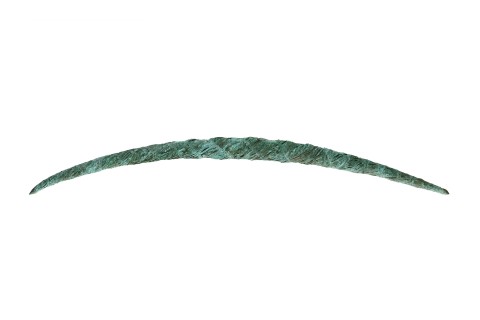SASH, 1994
BRONWYN OLIVER
copper
28.0 x 193.0 x 11.5 cm
Christine Abrahams Gallery, Melbourne
Western Mining Corporation, Melbourne
BHP Billiton, Melbourne, acquired within WMC Collection, June 2005
Sotheby’s, Melbourne, 24 November 2008, lot 1
Private collection, Sydney
Recent Work by Bronwyn Oliver, The 1994 Moët & Chandon Fellow, Christine Abrahams Gallery, Melbourne, 21 October - 16 November 1995, cat. 5
Fink, H., Bronwyn Oliver: Strange Things, Piper Press, Sydney, 2017, p. 114
With a fabric made of ruched sheet metal tightly bound with riveted struts, the long and narrow swag that is Sash, 1994 twists and strains, the warmth of its patinated copper evoking a living form enclosed within its sheathed package. This sculpture belongs to a small group of self-contained closed forms within Bronwyn Oliver’s oeuvre of latticed copper wire sculptures, poignantly evoking the artist’s own sense of geographical dislocation and protective remove. This sculpture also, however, conveys the possibility of metamorphosis, the potential of an unseen life force to break free of its cocoon.
There is a rich history of wrapped and bound forms in Western Art, from Michelangelo’s sculptures of bound slaves to Christo’s contemporary environmental interventions1, often illustrating tensions between constriction and escape, concealment and unveiling. This dichotomy has been a persistent thread within Bronwyn Oliver’s practice. Getting Through, one of her early performance pieces during a bush retreat with Marina Abramovic and Ulay in August 1981, featured Oliver trapped within a phonebooth, tied up with ropes. From within Oliver attempted to call her peers, asking them to release her binds from the outside. Many years later, Oliver’s series of closed form ‘Mute’ sculptures were similarly impregnable, containing a secret void within, tightly shielded from outside intervention.
Sash was created in Hautvillers, a village in Épernay, France, during Bronwyn Oliver’s year-long residency between 1994 – 1995. She had been the first sculptor to win the Moët & Chandon Art Fellowship some months earlier. By then, already one of Australia’s finest contemporary sculptors, Oliver had a dedicated following of private collectors and erudite critics. Armed with the tools of her trade and an unfortunately insufficient grasp of the French language, Oliver arrived in Épernay with the determined intention to ‘concentrate on my work away from my commitments. I can experiment with new techniques. I hope to get a forge there. This is not a year to waste.’2 It was only towards the end of her stay that she was able to fulfil this wish, with a delivery of oxyacetylene equipment allowing experimentation with sheet metal as opposed to copper shim, described by the artist as a ‘relief after weeks of fine, detailed concentration to be able to swing a hammer over an anvil.’3 Oliver has laboriously sewn and stitched the skin of this sculpture with fire and a rivet gun, endowing the warm material with a haptic quality of folded cloth. This quality is further magnified by the contrast between an uneven crystalline patination against Oliver’s regular criss-crossed binds.
In describing her most successful works, Bronwyn Oliver remarked that with a perfect combination of concept, medium and execution, the sculpture would ‘sing’, and using a ‘poetry of association’, would transcend conventional markers of time and space.4 The instinct to grapple with poetic associations is human, and a carefully laid trap that Bronwyn Oliver, as Ariadne, has woven for her audience. She drew inspiration from organic matter, prehistoric and ancient artefacts, and through a manipulation of surface texture and colour, was able to ‘incorporate the element of time’5 in her copper forms. The works of this small series all share a pleated surface inspired by a ‘dreadful sculpture seen at the Musée d’Orsay in 1990 – 91, a sculpture of a gladiator, in bronze, wearing ruched leggings, with musculature taut beneath the surface of the cloth.’6 Evoking an abandoned archaeological hoard or an ancient bundle of possessions wrapped for ease of carrying, Sash also expresses the nomadic transience of Oliver’s brief but stimulating sojourn in France.
1. Ian Howard, Oliver’s first art teacher, recalls having given a talk in Inverell on the subject of Christo’s Little Bay project in 1969, when he first met Oliver as a child. Fink, H., Bronwyn Oliver – Strange Things, Paper Press, Sydney, 2017, p. 11
2. The artist cited in Owen, S., ‘Career by Default’, The Sun-Herald, 13 February 1994, p. 142
3. The artist cited in Fink, op. cit., p. 114
4. Sturgeon, G., Contemporary Australian Sculpture, Craftsman House, Sydney, 1991, pp. 73 – 74
5. Oliver, B., ‘A Contemporary Australian Artist in France’, Explorations, The Institute for the Study of French-Australian Relations, Melbourne, December 1990, p. 27
6. The artist, cited in Bunyan, M., ‘Review of The Sculpture of Bronwyn Oliver at TarraWarra Museum of Art’, Art Blart, 28 January 2017
LUCIE REEVES-SMITH
